Abstract
Certain strains of mesophilic aeromonads (Aeromonas hydrophila, A. sorbria, and A. caviae), when grown in broth containing 0.5% glucose, undergo growth inhibition concomitant with acetate accumulation. Because these strains are nonviable after 24 h, this phenomenon is termed suicide. We investigated suicidal strains of Aeromonas species as a means of understanding animal virulence and enteropathogenicity. To assess virulence, batches of five white mice were inoculated intraperitoneally with 10(7) cells (washed) of suicidal and nonsuicidal strains of A. hydrophila and A. sobria and suicidal strains of A. caviae. The three nonsuicidal strains of A. sobria tested showed lethality as early as 12 h and were uniformly fatal within 36 h postinoculation. After 36 h, the three suicidal strains killed only 1 of 15 mice inoculated. Four A. hydrophila strains tested which showed the suicide phenomenon at 37 degrees C were variably lethal (40 to 100%). None of three suicidal strains of A. caviae were lethal. Enteropathogenicity was studied by orally inoculating three white mice each with the same Aeromonas strains (10(8) cells, in skim milk) and assessing diarrhea and intestinal fluid accumulation. Diarrhea and fluid accumulation were present in all mice inoculated with two nonsuicidal strains of A. sobria and in 4 of 12 mice given four suicidal strains of A. hydrophila. Two suicidal strains each of A. sorbria and A. caviae failed to elicit any gastrointestinal disturbances. These data suggest that the suicide phenomenon may explain strain-specific (A. sobria and A. hydrophila) and species-specific (A. caviae) virulence and enteropathogenicity.
Full text
PDF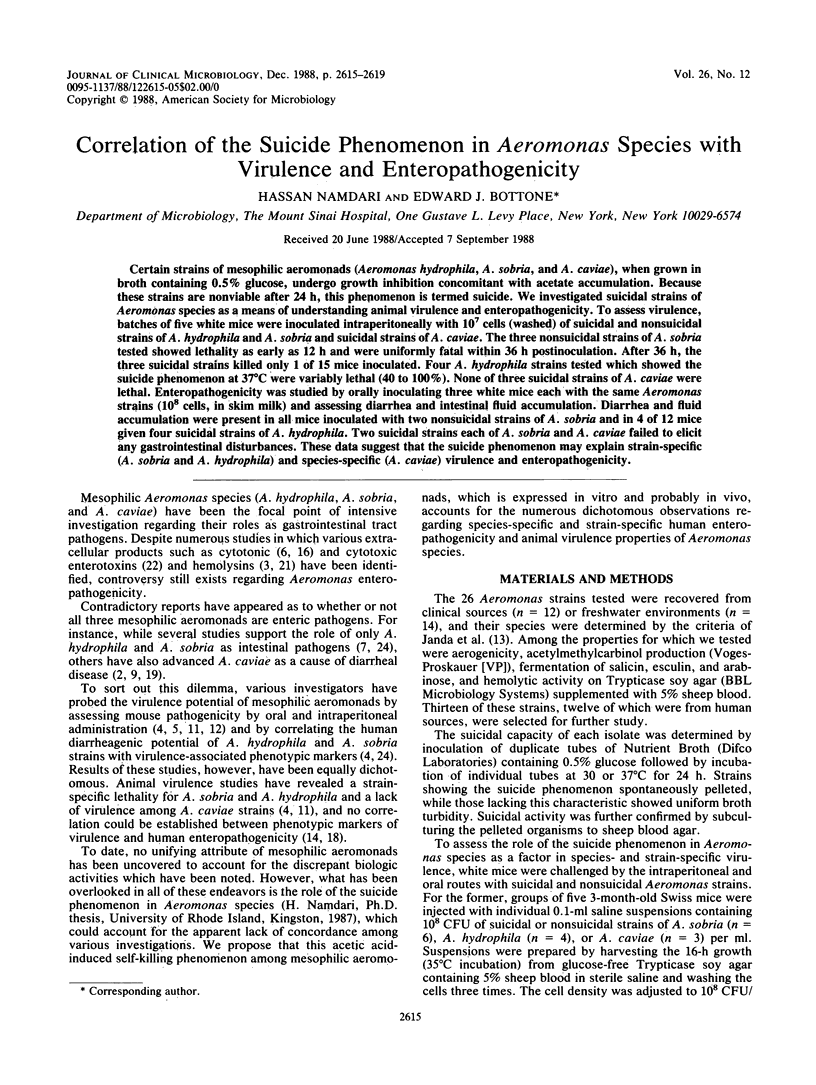
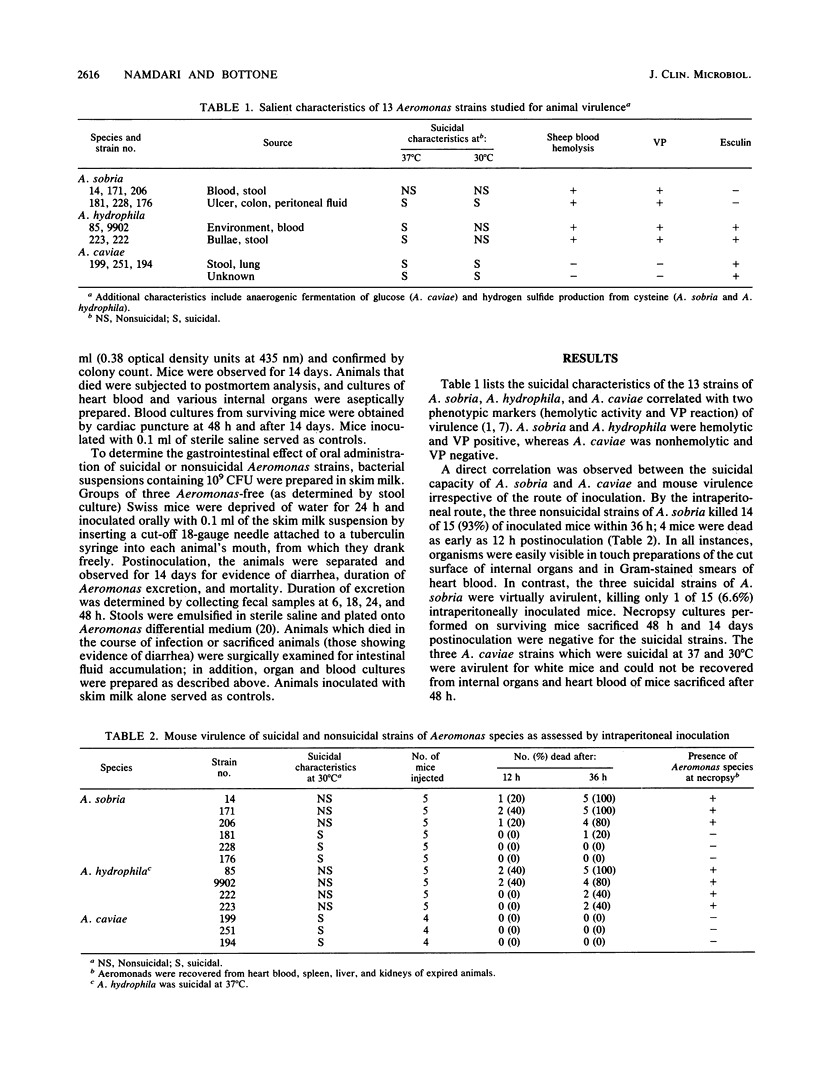
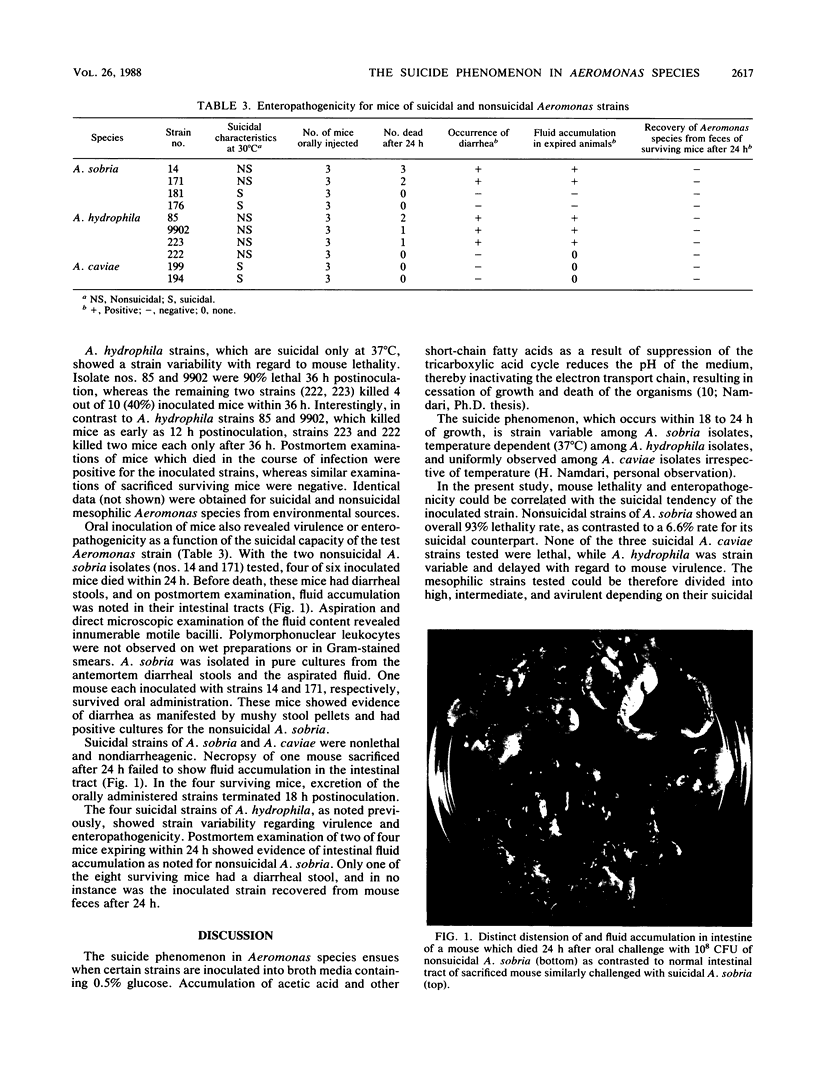
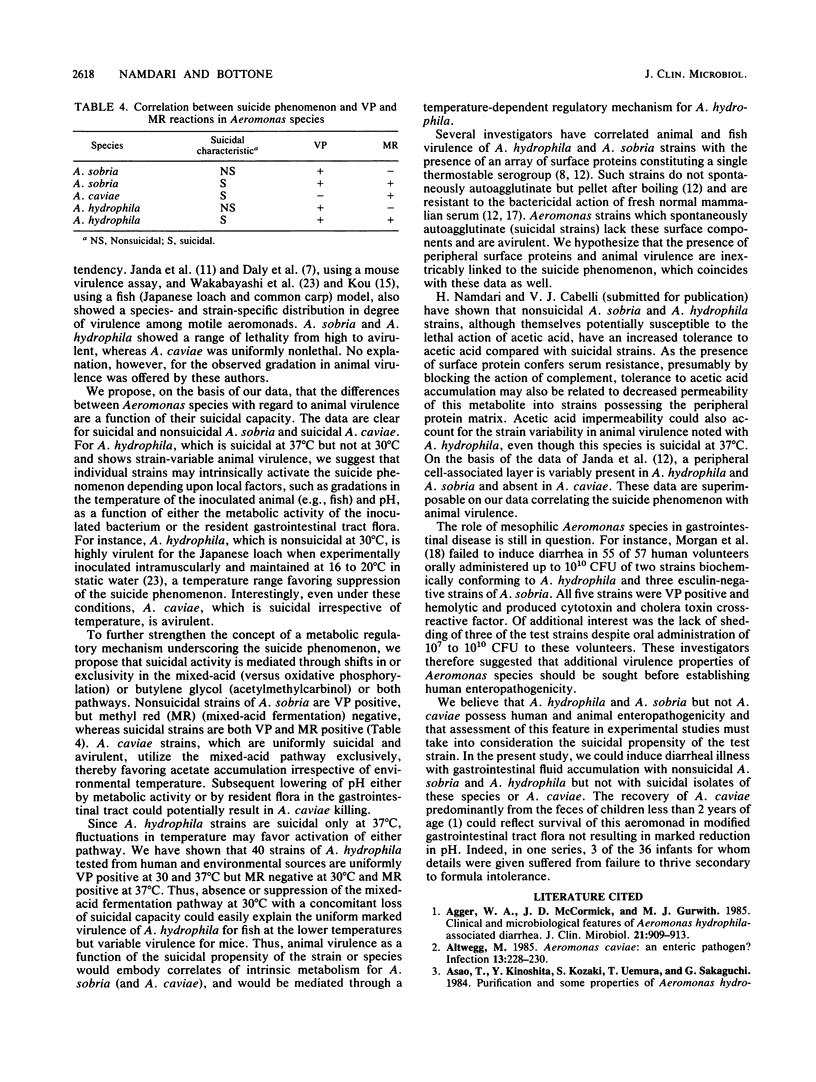
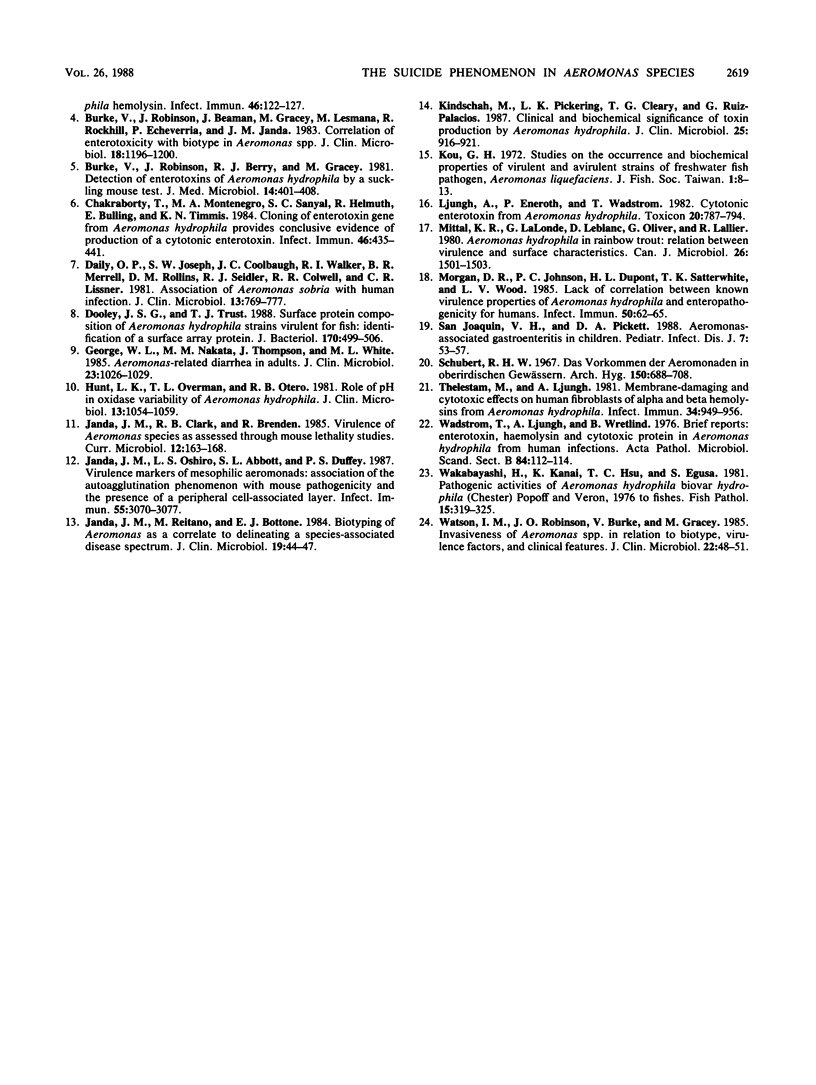
Images in this article
Selected References
These references are in PubMed. This may not be the complete list of references from this article.
- Agger W. A., McCormick J. D., Gurwith M. J. Clinical and microbiological features of Aeromonas hydrophila-associated diarrhea. J Clin Microbiol. 1985 Jun;21(6):909–913. doi: 10.1128/jcm.21.6.909-913.1985. [DOI] [PMC free article] [PubMed] [Google Scholar]
- Altwegg M. Aeromonas caviae: an enteric pathogen? Infection. 1985 Sep-Oct;13(5):228–230. doi: 10.1007/BF01667217. [DOI] [PubMed] [Google Scholar]
- Asao T., Kinoshita Y., Kozaki S., Uemura T., Sakaguchi G. Purification and some properties of Aeromonas hydrophila hemolysin. Infect Immun. 1984 Oct;46(1):122–127. doi: 10.1128/iai.46.1.122-127.1984. [DOI] [PMC free article] [PubMed] [Google Scholar]
- Burke V., Robinson J., Beaman J., Gracey M., Lesmana M., Rockhill R., Echeverria P., Janda J. M. Correlation of enterotoxicity with biotype in Aeromonas spp. J Clin Microbiol. 1983 Nov;18(5):1196–1200. doi: 10.1128/jcm.18.5.1196-1200.1983. [DOI] [PMC free article] [PubMed] [Google Scholar]
- Burke V., Robinson J., Berry R. J., Gracey M. Detection of enterotoxins of Aeromonas hydrophila by a suckling-mouse test. J Med Microbiol. 1981 Nov;14(4):401–408. doi: 10.1099/00222615-14-4-401. [DOI] [PubMed] [Google Scholar]
- Chakraborty T., Montenegro M. A., Sanyal S. C., Helmuth R., Bulling E., Timmis K. N. Cloning of enterotoxin gene from Aeromonas hydrophila provides conclusive evidence of production of a cytotonic enterotoxin. Infect Immun. 1984 Nov;46(2):435–441. doi: 10.1128/iai.46.2.435-441.1984. [DOI] [PMC free article] [PubMed] [Google Scholar]
- Daily O. P., Joseph S. W., Coolbaugh J. C., Walker R. I., Merrell B. R., Rollins D. M., Seidler R. J., Colwell R. R., Lissner C. R. Association of Aeromonas sobria with human infection. J Clin Microbiol. 1981 Apr;13(4):769–777. doi: 10.1128/jcm.13.4.769-777.1981. [DOI] [PMC free article] [PubMed] [Google Scholar]
- Dooley J. S., Trust T. J. Surface protein composition of Aeromonas hydrophila strains virulent for fish: identification of a surface array protein. J Bacteriol. 1988 Feb;170(2):499–506. doi: 10.1128/jb.170.2.499-506.1988. [DOI] [PMC free article] [PubMed] [Google Scholar]
- George W. L., Jones M. J., Nakata M. M. Phenotypic characteristics of Aeromonas species isolated from adult humans. J Clin Microbiol. 1986 Jun;23(6):1026–1029. doi: 10.1128/jcm.23.6.1026-1029.1986. [DOI] [PMC free article] [PubMed] [Google Scholar]
- Hunt L. K., Overman T. L., Otero R. B. Role of pH in oxidase variability of Aeromonas hydrophila. J Clin Microbiol. 1981 Jun;13(6):1054–1059. doi: 10.1128/jcm.13.6.1054-1059.1981. [DOI] [PMC free article] [PubMed] [Google Scholar]
- Janda J. M., Oshiro L. S., Abbott S. L., Duffey P. S. Virulence markers of mesophilic aeromonads: association of the autoagglutination phenomenon with mouse pathogenicity and the presence of a peripheral cell-associated layer. Infect Immun. 1987 Dec;55(12):3070–3077. doi: 10.1128/iai.55.12.3070-3077.1987. [DOI] [PMC free article] [PubMed] [Google Scholar]
- Janda J. M., Reitano M., Bottone E. J. Biotyping of Aeromonas isolates as a correlate to delineating a species-associated disease spectrum. J Clin Microbiol. 1984 Jan;19(1):44–47. doi: 10.1128/jcm.19.1.44-47.1984. [DOI] [PMC free article] [PubMed] [Google Scholar]
- Kindschuh M., Pickering L. K., Cleary T. G., Ruiz-Palacios G. Clinical and biochemical significance of toxin production by Aeromonas hydrophila. J Clin Microbiol. 1987 May;25(5):916–921. doi: 10.1128/jcm.25.5.916-921.1987. [DOI] [PMC free article] [PubMed] [Google Scholar]
- Ljungh A., Eneroth P., Wadström T. Cytotonic enterotoxin from Aeromonas hydrophila. Toxicon. 1982;20(4):787–794. doi: 10.1016/0041-0101(82)90126-x. [DOI] [PubMed] [Google Scholar]
- Mittal K. R., Lalonde G., Leblanc D., Olivier G., Lallier R. Aeromonas hydrophila in rainbow trout: relation between virulence and surface characteristics. Can J Microbiol. 1980 Dec;26(12):1501–1503. doi: 10.1139/m80-248. [DOI] [PubMed] [Google Scholar]
- Morgan D. R., Johnson P. C., DuPont H. L., Satterwhite T. K., Wood L. V. Lack of correlation between known virulence properties of Aeromonas hydrophila and enteropathogenicity for humans. Infect Immun. 1985 Oct;50(1):62–65. doi: 10.1128/iai.50.1.62-65.1985. [DOI] [PMC free article] [PubMed] [Google Scholar]
- San Joaquin V. H., Pickett D. A. Aeromonas-associated gastroenteritis in children. Pediatr Infect Dis J. 1988 Jan;7(1):53–57. doi: 10.1097/00006454-198801000-00013. [DOI] [PubMed] [Google Scholar]
- Schubert R. H. Das Vorkommen der Aeromonaden in oberirdischen Gewässern. Arch Hyg Bakteriol. 1967 Mar;150(7):688–708. [PubMed] [Google Scholar]
- Thelestam M., Ljungh A. Membrane-damaging and cytotoxic effects on human fibroblasts of alpha- and beta-hemolysins from Aeromonas hydrophila. Infect Immun. 1981 Dec;34(3):949–956. doi: 10.1128/iai.34.3.949-956.1981. [DOI] [PMC free article] [PubMed] [Google Scholar]
- Wadström T., Ljungh A., Wretlind B. Enterotoxin, haemolysin and cytotoxic protein in Aeromonas hydrophila from human infections. Acta Pathol Microbiol Scand B. 1976 Apr;84(2):112–114. doi: 10.1111/j.1699-0463.1976.tb01911.x. [DOI] [PubMed] [Google Scholar]
- Watson I. M., Robinson J. O., Burke V., Gracey M. Invasiveness of Aeromonas spp. in relation to biotype, virulence factors, and clinical features. J Clin Microbiol. 1985 Jul;22(1):48–51. doi: 10.1128/jcm.22.1.48-51.1985. [DOI] [PMC free article] [PubMed] [Google Scholar]



